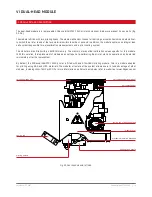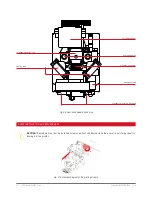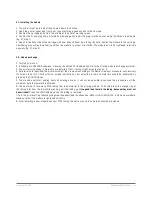
84 | 3DGence INDUSTRY F340
Extruder
– a part of the 3D printer working in the FFF technology. It is designed to feed the filament at a strictly defined rate,
and consequently – quantity. The 3DGence INDUSTRY F340 printer is fitted with a Bowden type extruder. It means that extru
-
der motors are located beyond the moving printer parts, leading material to the head via the PTFE tubing. It makes the design
lighter and has a positive impact on the print quality.
Endstop
– an optoelectronic switch that limits a 3D printer movement beyond the maximum range. The device is fitted with
3 optical endstops – one for each axis. The optical endstop does not require any physical contact with the corresponding
interrupter, which provides its long life, however one should notice that it is sensitive to the sources of bright light which may
result in triggering its false operation.
Filament
– popular description for material used to print in fused deposition modeling (FFF) technology. The filament is a ther
-
moplastic wire (PLA, ABS, PVA, HIPS, PC, Nylon or other) generated with specific tolerances The filament is wound on a spool.
The relevant parameters when selecting a filament include: dimensional tolerance and the method for protection against mo
-
isture (optimally the filament should be vacuum packed with a moisture absorber.) A high diameter of the spool hub provides
an opportunity to use its entire length – an excessive bending of the filament (e.g. on a small spool hub) can cause problems
with its application. The filament after opening the package should be stored in a dark, dry place with a moisture absorber.
CAUTION:
using materials from beyond the Base of Certified Materials disables the use of SMM system.
Firmware – an internal software for 3D printer. It is responsible for interpreting the commands contained in the machine code
(G code). The effects of its operation include the basic signals for heaters, motors and fans. It is responsible for interpreting
accelerations, temperature correction tables and many other factors. A well tuned firmware makes up an important machine
calibration element, as it corresponds to adjusting pick-ups, accelerations and other key parameters for device performance.
G-Code
– is a normalized programming language adjusted to control CAM machines. In simple words, the G code string inc-
ludes machine instructions – in what direction, how fast and along which axis to move. The code for printers is generated by
slicing software (slicers). It stores all the data on subassembly temperatures and the revs of motors in a precision sequence
that results in moving the head and defines the extruder behavior. The code commands are sent line by line to the printer
controller processor during the printing process. The processor interprets the code based on its software and sends specific
signals to particular components.
Skipping steps
– under abnormal motor and controller operating conditions (e.g. too high temperature, mechanical resistance)
the motor can skip operation steps. This can be noticed after moving the printing plane in the axis in which the motor skipped
steps. The visual effects of this failure depend on the path the head moves along in relation to the table. To make it better
imaginable let’s assume that the print is a cube and the printer skipped steps in the middle of the print. The printed solid would
look as if it was cut in two in XY plane and glued with a certain displacement.
HIPS
(High-Impact Polystyrene) – a styrene polymer. It is used mainly in 3D printing
as a material for printing support structures for ABS plastic. It is soluble in d – limonene It features a high impact resistance
and a low flexibility.
Normal
– a colloquial term used in 3D modeling to name a vector normal to a plane. The normal vector is a vector perpendicular
to a plane or in the case of other planes perpendicular to the plane, tangential to the surface in a specific point. In 3D mode
-
ling its orientation defines the solid interior and exterior In a majority of cases it is assumed that a correct normal is oriented
outwards the solid.
Nylon
– a group of polyamide materials developed by DuPont company. Currently, these are used also for producing resistant
filaments for 3D prints. Its main advantage includes its high mechanical and chemical strength, possibility of further proces
-
sing and coloring with textile dyes. Prints feature also some flexibility and resistance to rupture.
OBJ
– a popular format of 3D files. It may contain an additional MTL (Material Template Library) file irrelevant for FFF print, con
-
taining information on material libraries defined for the model. OBJ files apart from the geometry description, apex layout and
normal orientations includes information on UV coordinates for textures. It is read by the 3DGence Slicer program.
PLA
(polylactide – a lactic acid polymer) – produced in industrial quantities with use of eco-friendly methods. The main sources
for initial materials include grains, e.g. cornflour or bacterial cultures. This is a basic material for FFF technology 3D printing.
Summary of Contents for INDUSTRY F340
Page 1: ...USER MANUAL 3DGence INDUSTRY F340 ...
Page 2: ...2 3DGence INDUSTRY F340 ...
Page 39: ...3DGence INDUSTRY F340 39 version 1 0 07 2017 ...
Page 43: ...3DGence INDUSTRY F340 43 version 1 0 07 2017 ...
Page 86: ...86 3DGence INDUSTRY F340 ...
Page 87: ......




































